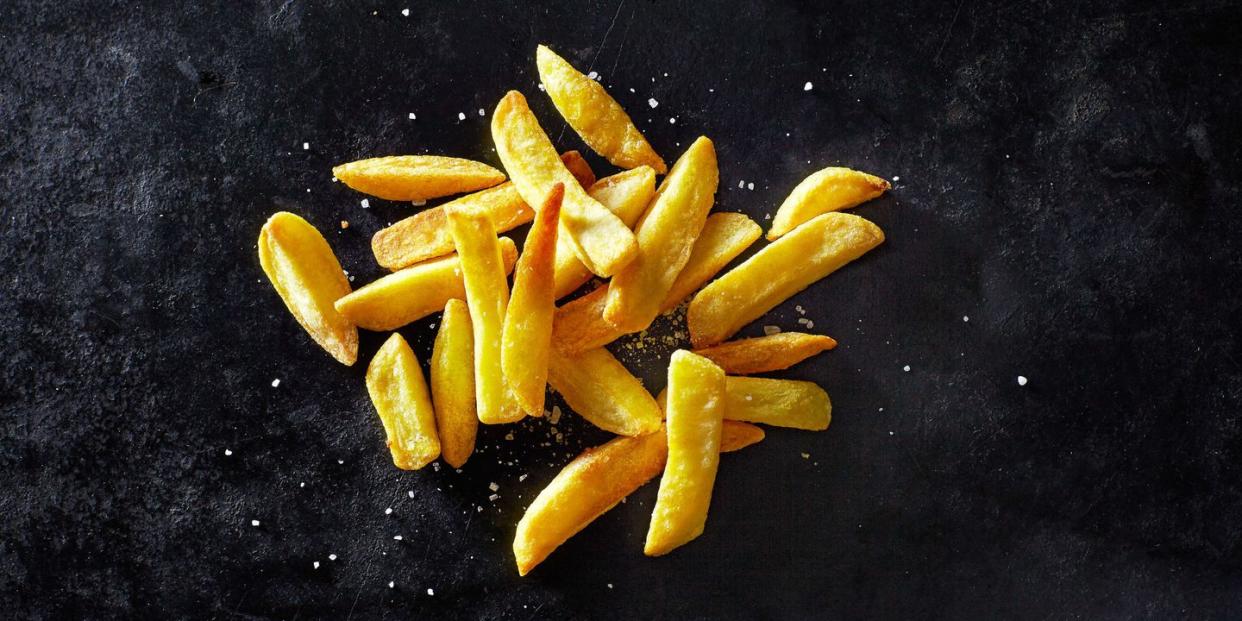The Definitive Ranking of French Fries

We ask so little of our hamburger chains. Really. The bar is low indeed, and it gets lower every year as beef gets nastier and eateries discover more creative ways to make bad hamburgers. (Currently, Burger King cooks the patties hours ahead of time and keeps them in a little plastic drawer, to be microwaved on pickup. How depressing is that?)
But at least you can depend on their french fries. At their best, french fries are potato batons, cut to tolerances of a fraction of an inch, turned to gold by that King Midas, hot oil. They drop into the fryer with a festive splatter, and emerge crisp on the outside and moist and starchy on the inside, requiring no condiments, no melted cheeses, no sauces or specialty buns.
For me, the very best french fries have thousands of microfissures created by expanding ice crystals. When immersed in a seething cauldron, these fries are penetrated through with grease, becoming almost translucent. They are a pure vehicle for fat and flavor and fine salt crystals: the perfect food. And so, here I give you a ranking of the handiwork of the most monumental fry-makers of our time—starting with those that somehow manage to screw up perfection.
6. Five Guys/Wendy's

I group these fries together not just because both are so bad—limp and stale and tasteless and mealy—but also because their faults lie in the same misguided preparation method. The idea has for some reason spread that hand-cut french fries are better than frozen french fries. They're not. Frozen french fries, like their more evolved cousin the tater tot, are the product of decades of food-service potato technology. Cooked in boxcar-size oil boilers at the Simplot or Ore-Ida factory, they're meant to fry up crispy and tasty. Hand-cut fries might have a fighting shot at being good if they were blanched before frying, but they aren't, so they don't. Let's move on.
5. Burger King

Burger King has two different fries at the moment: the traditional Simplot straight-cut fries (the 3/8-inch version, unless I miss my guess), the industry standard; and the new low-cal, low-fat Satisfries. Incredible as this is to say, Satisfries are actually better than the regular fries. This strange fact, I believe, can be credited entirely to the Satisfries' crinkle-cut shape, which gives them more surface area to crust up, as well as a nostalgic appeal to XXL men of a certain age. Why are there no crinkle cuts in the quick-service restaurant sector? This remains the enduring french fry mystery of our time. Remember, Burger King once had a dominating french fry whose potato starch dusting gave it a jaw-dropping taste and texture. But this radical innovation proved too much for the chain's staid consumer base, and was soon abandoned.
4. McDonald's

It will surprise no one that McDonald's comes out on top in the endless "crown versus clown" war. And it's not hard to see why: Its fries are more or less the same as Burger King's fries, but hotter and fresher and saltier (no doubt as a result of the chain's legendarily huge operations manual and the attentiveness of its bio-bots). It should be noted here that the McDonald's fries were once truly great, and deserving of their iconic stature, but that was back in the good old days, when they were cooked in leftover beef tallow.
3. Steak 'n' Shake

There is no question that I am biased here. Steak 'n Shake is my favorite hamburger chain of all time. Its stark and simple single burger remains the platonic ideal of what a chain hamburger should be. You may feel this way about In-N-Out, and that's fine with me: The two resemble each other as much as one Olsen twin does the other, and to my mind are even more lovely. But surely no one can doubt that Steak 'N Shake's fries are better. They are the smallest, thinnest, and crispiest of fast-food fries, approaching shoestring diameter. In one greasy grasp you can grab six or seven of these, which can be said to be all surface for all intents and purposes. You can even put them on the burger, unnatural as that might seem.
2. Nathan's

Having dispensed with the major burger chains, we will now investigate the specialty fries produced by niche sectors. Take Nathan's. The Nathan's hot dog is a disgrace to its name, a grossly overpriced and overcooked tube served on a stale, cold bun. But the Nathan's fries—fat, soft, salty steak fries with a kind of wide-wale texture—have an interior that, unlike the parched and powdery interior of hand-cut fries, is more like boiled potatoes, moist and not without some semblance of potato flavor. And since they aren't really meant to be crispy, they travel well.
1. KFC

I considered barring KFC's potato wedges from this list. Once you start letting in specialty products like this, where do you stop? Are the Arby's potato cakes included? Or Chick-fil-A's waffle fries? What of Sonic's tater tots, the crown jewel of fried food-service potatoes? This is a valid enough argument, I think, but I don't give a shit. I love KFC's potato wedges almost as much as I love its chicken. The wedges are crusted with seasoned batter, and vary from a thin, all-crunch edge to a thick, potato-y, steak fry–like side. They are always dry and appetizing, and never marred by the steaming of a closed bag. They aren't served hot, but that doesn't matter, because they are at their best when warm. KFC is the winner of the french fry contest by a Secretariat-like margin. In fact, I wish I had some now.
You Might Also Like

